Cutting-edge grid innovation is coming to a small Portuguese island in the Atlantic.
French carmaker Groupe Renault said last month that it would collaborate with island authorities and grid operator Empresa de Electricidade da Madeira (EEM) on a project called Sustainable Porto Santo/Smart Fossil Free Island, which will include vehicle-to-grid (V2G) technology. The project grapples with the challenges of increasing variable renewables on a small island grid.
In the first phase, costing €9 million ($11 million), the island will install 40 charging points for 14 Renault Zoe electric cars and six Kangoo electric vans.
At the end of this year, these vehicles will start acting in V2G mode to help the grid cope with demand peaks.
Finally, Renault will install energy storage, based on second-life EV batteries, so the renewable energy capacity on the island can be increased without curtailment.
The carmaker is working with a U.K. company called Powervault on its second-life battery technology, although “at this stage the [Porto Santo] project with Renault has not been discussed,” said Powervault’s business development associate Tom Ross.
“This world-first smart island uses electric vehicles, second-life batteries, smart charging and V2G to boost the island’s energy independence and stimulate the production of renewable energy,” Renault claimed in a press release.
Contrary to that messaging, though, the project is not the only smart island program using vehicle electrification in combination with renewables.
On the Isles of Scilly, off the English coast and 1,250 miles northeast of Porto Santo, the European Union is funding another smart island project that combines electric vehicles and solar power, with heat pumps plus energy storage and charging control systems from Moixa.
Nor is Sustainable Porto Santo initially going to result in a fossil-free island.
Instead it is hoped the project will allow the isle, which is the smaller of two inhabited islands in the Madeira archipelago, to the west of Morocco, to increase its share of renewable energy from 15 percent today to around 19 percent by mid-2019.
With an area of 16 square miles and a population of around 5,500, which swells in summer due to tourism, Porto Santo consumes 33.2 gigawatt-hours of electricity a year.
Of this, 85 percent comes from fuel oil, 11 percent from solar PV and 4 percent from wind, according to Agostinho Figueira, director at EEM.
He said the smart island project is already underway, with tenders in progress for smart grid sensors, monitoring and remote control platforms, smart meters, communications technology, advanced metering infrastructure, advanced distribution management systems and batteries.
Longer-term, Porto Santo has two options for replacing fossil-fuel generation, Figueira said.
One is to continue building up the storage capacity on the island, although even in a best-case scenario it would only be financially viable to achieve up to around an 80 percent penetration of renewables. This is because Porto Santo’s energy consumption doubles over the three months of summer, owing to the impact of tourism.
“It is possible to get to 100 percent renewables, but the efficiency is low,” Figueira said.
The second option would be to develop enough renewable capacity to cope with the summer demand peak and export the excess to Madeira at other times of year, over an as-yet-unbuilt interconnector. Madeira’s much larger size and lake-studded highlands might enable the excess energy to be stored in pumped hydro reserves.
However, it is unclear if Porto Santo islanders would welcome a major build-out of solar and wind infrastructure on their isle, which remains relatively unspoiled despite tourism.
In any case, said Figueira, “Even in a scenario of 100 percent renewable electricity, the diesel plant will remain on Porto Santo, as a backup system.”
The project will likely be watched by observers tracking a growing number of microgrid projects on Atlantic islands, including Graciosa in the Azores and El Hierro and La Graciosa in the Canary Islands.
“The Madeira pilot, like our Isles of Scilly project, is creating a showcase for what’s possible with today’s technology to prepare for rising vehicle numbers,” Moixa CEO Simon Daniel told GTM.
The pilots could help encourage local electricity companies to upgrade their infrastructure, said Rick Szijarto, senior solution marketing manager at the smart grid developer Tantalus Systems.
“It’s important that the utilities are able to receive more granular data in order to responsively control local loads, to effectively manage the overall load on distribution assets like transformers,” he said.




